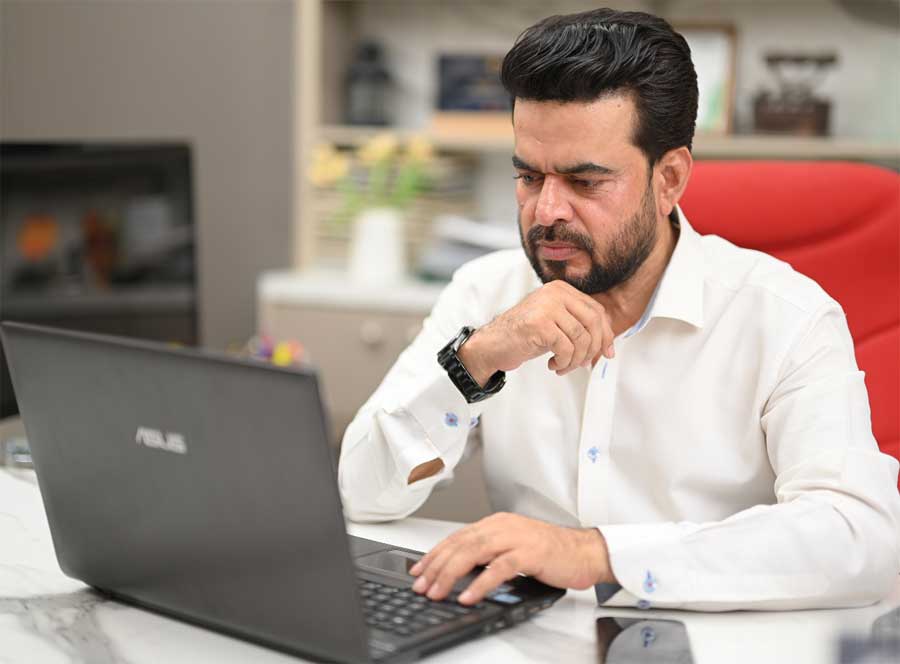TFD Report
KARACHI: In recent years, technology has dramatically transformed the fashion industry, reshaping both design processes and retail practices. Advancements in technology are playing a significant role in driving innovation within the Pakistani fashion industry. From 3D printing to virtual reality (VR) fashion shows, designers are harnessing technology to push the boundaries of creativity and craftsmanship.
One of the most significant changes brought about by technology is the integration of digital design tools. Designers now have access to sophisticated software that allows them to create intricate designs and visualize their ideas in 3D. This technology streamlines the design process, enabling designers to experiment with various patterns, colors, and styles without the need for physical prototypes. As a result, the time taken to bring a concept to market has significantly decreased, allowing fashion brands to respond more swiftly to emerging trends.
Senior fashion designer Moazzam Khan says “AI is transforming the fashion business by streamlining operations such as product development, supply chain optimization, and marketing. Tools such as trend analysis, generative design, inventory management, and virtual try-ons improve creativity, efficiency, and sustainability.”
He added “Another crucial aspect of technology’s impact on fashion designs is the growing trend of sustainability. Advanced technologies such as 3D printing and sustainable fabric production techniques are enabling designers to create eco-friendly collections. This shift toward sustainability resonates with environmentally conscious consumers, fostering brand loyalty and promoting a more responsible fashion industry.”
Previously Moazzam Khan’s design team worked manually. They drafted patterns by hand on paper and assessed design and fit with physical samples. Moazzam explains, “There was a lot of human error. When it went into production, we saw a lot of fit and grading issues.” Moazzam attributes these issues to the minute differences in the “hand” of each designer. These small differences translate to bigger disparities in bulk production.
With a vision to expand, the IT team also saw a need for more robust infrastructure in the design department. Growing globally requires scalability. Scalability requires lower lead times, higher levels of technology, and higher levels of automation. For this reason, Moazzam Khan initiated a digital design transformation department in his studio.
Pakistani bridal dress tailoring typically involves intricate hand embroidery, often using techniques like zardozi, dabka, and gota work, along with embellishments like sequins and beads. The designs are rich, complicated and traditional, featuring floral or geometric patterns and often covering the entire dress, especially the neckline, hem, and sleeves. It requires intensively balanced tailoring. Addition of technology reduces the chances of human error possibilities.
Worldwide, the fashion designers work from graded digital pattern blocks. This frees them to make style line changes without disturbing the fit. Since every style comes from the same blocks, fit is more consistent between styles. In addition, the fashion designers simulate their styles. They understand how each garment will drape and fit with real-time motion simulation. The draped silhouettes become like digital “blanks” for designers to visualize their artwork. They arrange repeats, placement prints, and embroideries on the 3D sample. Then each department reviews the full collection digitally, before any physical samples are made. Since design evaluations now happen virtually, the team makes decisions quickly without wasting resources. The designers focus on creativity, rather than getting involved with administrative or operational issues.
Pakistani fashion evolution is deeply inspired by its rich culture. It is a perfect replica of tradition, culture with modern cuts. Over the years, it has changed and evolved. Technology has reshaped how the Pakistani fashion industry used to be. The textile industry is the backbone of Pakistan’s fashion scene. There have been significant changes over the years in the Pakistani fashion industry, which have made it easier to bring in the most creative ideas.
Innovation in Pakistani textiles is no longer restricted to local runways; it’s making its mark globally. Esteemed designers like Moazzam Khan have brought the elegance and vibrancy of Pakistani couture to the world stage. Events like the Pakistan Fashion Design Council (PFDC) and Fashion Pakistan Week (FPW) have become prime platforms for showcasing the creative brilliance of such designers. These high-profile gatherings not only celebrate local talent but also attract international buyers and media, paving the way for exciting global collaborations.
Moazzam Khan says “I don’t mean to replace technology with my incredibly talented and dedicated artisans. The impact of the Pakistani fashion industry extends beyond aesthetics-it’s transforming lives. Many saree brands are now partnering with local artisans, giving them a platform to display their remarkable craftsmanship in sarees, too. This collaboration not only preserves traditional techniques but also provides artisans with a steady income and wider recognition for their work.”
“Women are the backbone of Pakistan’s fashion industry, contributing their skills in stitching, embroidery, and more. Recognizing their vital role, many initiatives within the industry focus on fair wages and training programs, enabling women to gain financial independence and improve their quality of life,” Moazzam Khan tells The Financial Daily.




